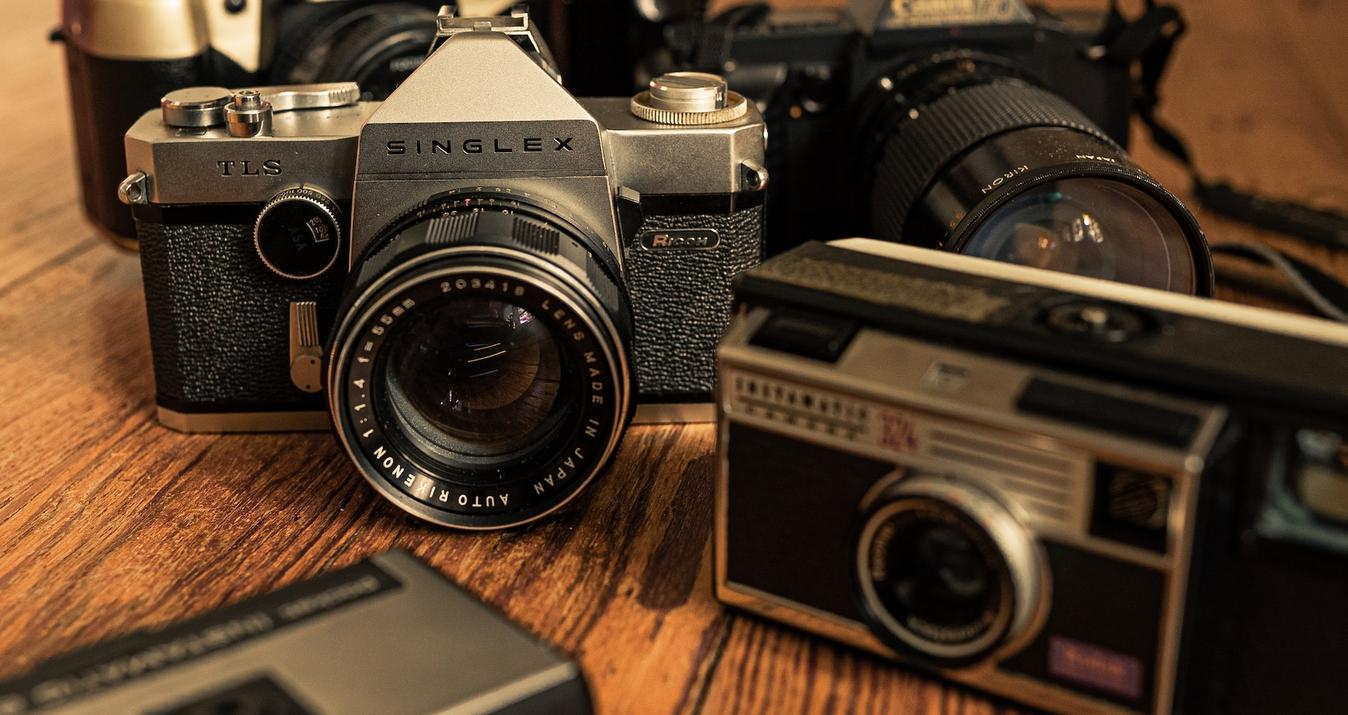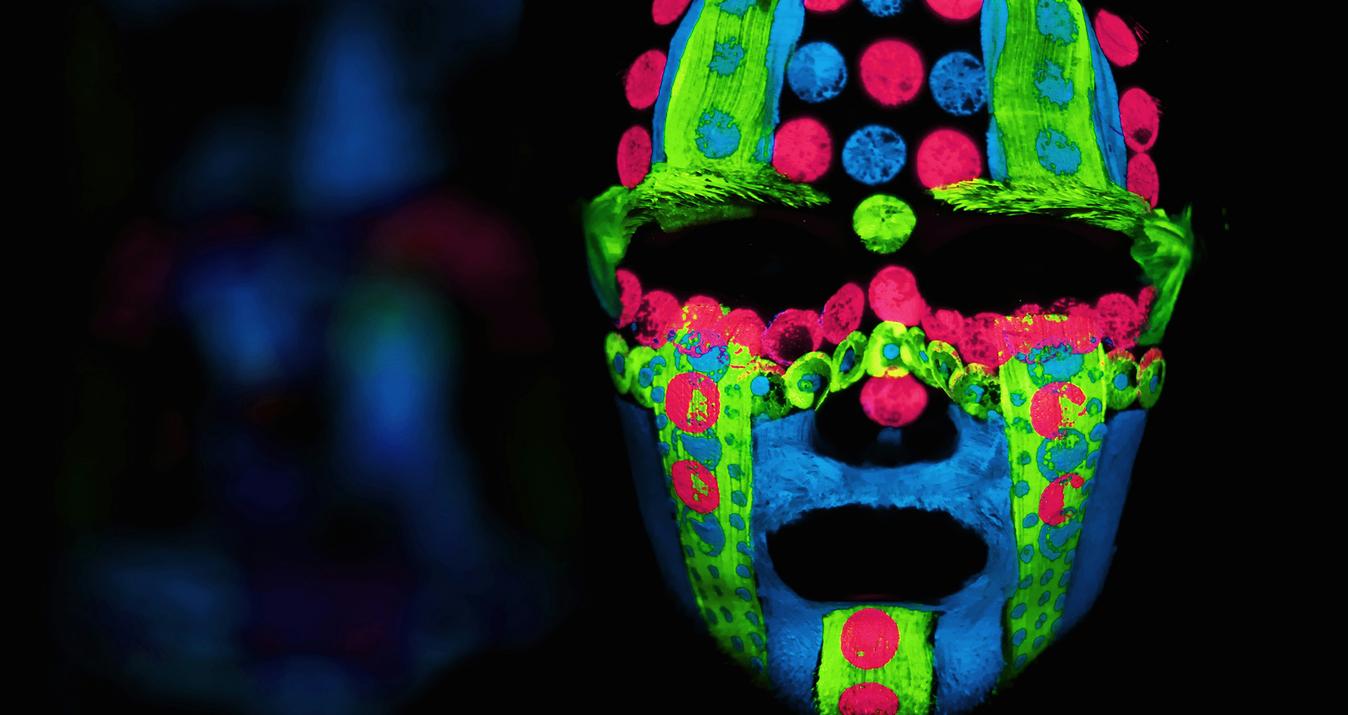101 Photography Facts To Blow Your Mind!
October 17, 2024

Have you ever wondered what photography was like one hundred or even more years ago? If you said yes, then these facts about photography are going to blow your mind!
Photography has existed for a long time and the photography world has grown at an amazing pace. What was once an arduous process that took hours to complete, with heavy and complicated equipment to master and handle, now takes literally seconds. You can just pull out your phone, open an app, touch a virtual button, and take a photo.
This amazing transformation of the art form has given photography a rich history and an exciting present. That’s why we’re honoring the art of photography by highlighting some fun facts about photography that you may have never heard.
Interesting Photography Facts
1. The word “photography” is derived from the Greek words photos (light) and graphé (representation by means of lines). It literally means “drawing with light”.
FREE set of solar eclipse presets for Luminar to make processing your eclipse shots a snap!
15. Anyone who knows anything about photography is familiar with Adobe Photoshop. But most people don’t know that the software was originally developed by the Knoll brothers in 1987 and titled ImagePro. It was then bought by Adobe and turned into Photoshop.
16. Digital imaging is good for the environment! Many darkroom chemicals are toxic and dangerous to handle. Disposing of them by pouring them down the drain or through other conventional means is polluting. Pat yourself on the back the next time you open your photo editing software!
17. The world’s largest camera collection belongs to Dilish Parekh of Mumbai. He owns approximately 4,500 cameras!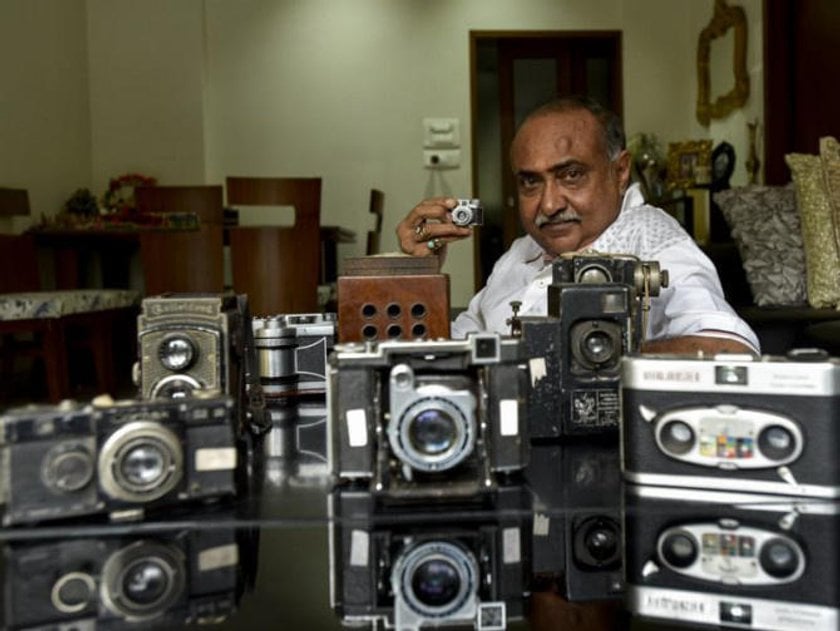 Dilish Parekh
Dilish Parekh
18. The first device made to project an image on a surface was the camera obscura, or dark room in Latin. The principle was first recorded by Mozi, a Chinese philosopher, around 470 to 391 BCE. The camera obscura was the basis for what we know as a pinhole camera.
19. Every two minutes, we take more pictures than all humankind did in the entirety of the 1800s.
20. The equivalent f-stop values for the human eye are f/8.3 in bright environments and f/2 in the dark.
21. There are 12 Hasselblad cameras on the surface of the moon. They were left there to leave room for the moon rocks brought back to Earth. The film magazines, of course, made the return flight.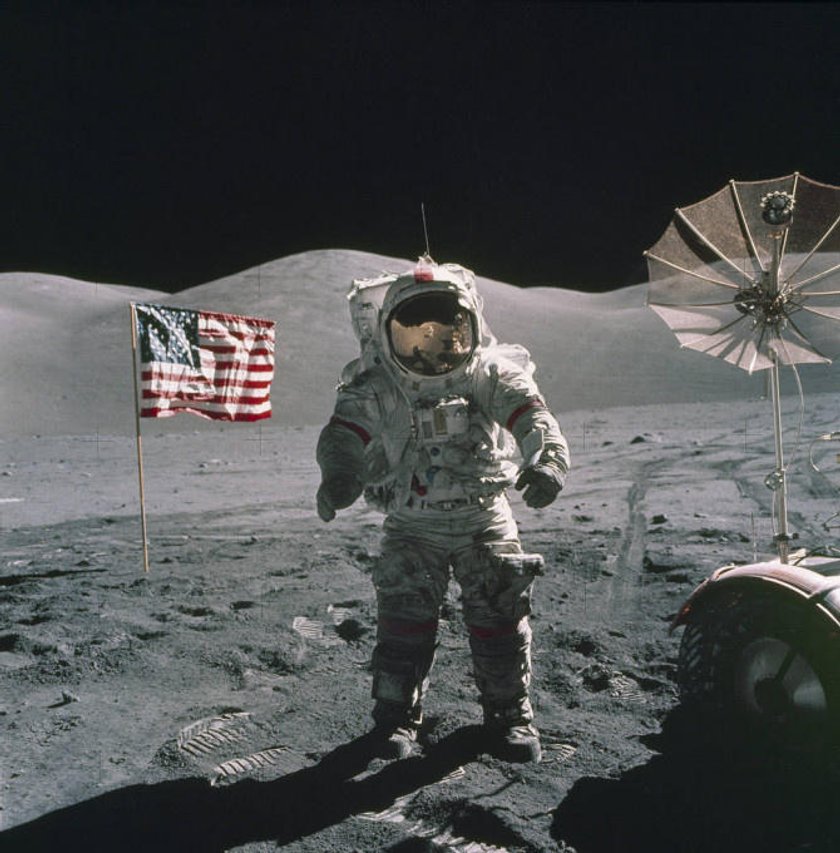 ©NASA
©NASA
22. Steve Sasson of Eastman Kodak invented the first digital camera in 1975. It weighed eight pounds, recorded an image on a cassette tape, and took 23 seconds to “snap” a picture. Oh, and the resolution? 0.01 megapixels!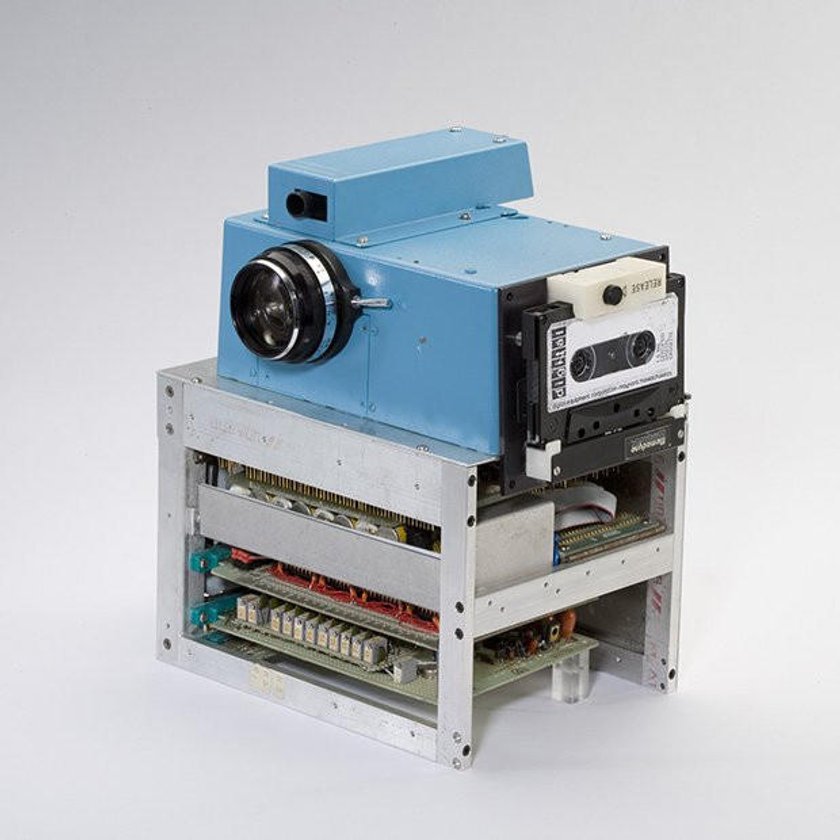 ©Kodak
©Kodak
23. Here’s one for your friends that don't like “manipulated” images. The photos of the iconic, early twentieth-century American photographer Ansel Adams were often manipulated in the darkroom. The most common adjustments were dodging and burning.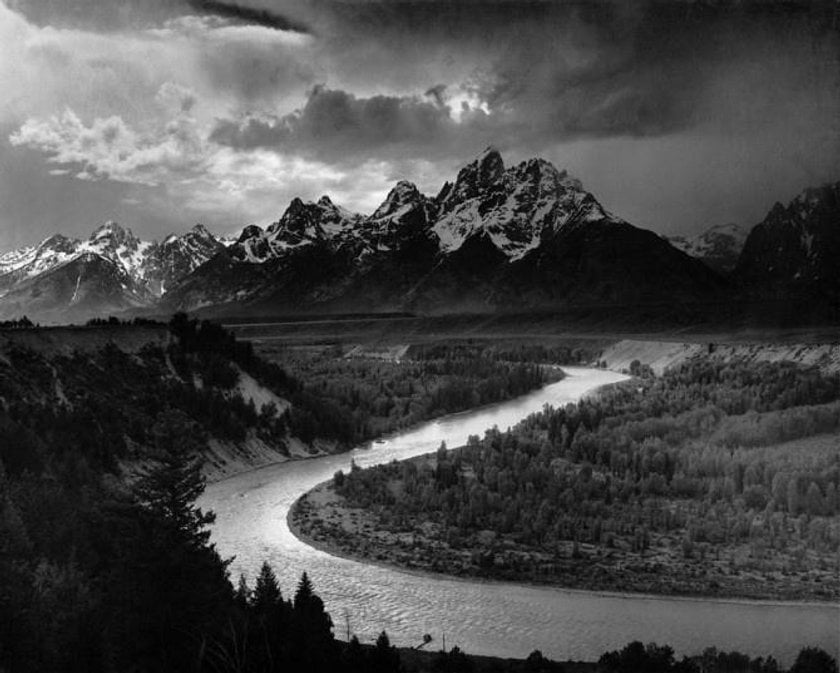 The Tetons and the Snake River, by Ansel Adams (1942)
The Tetons and the Snake River, by Ansel Adams (1942)
24. The concept of HDR images isn’t new. Photographers have always needed to overcome the limited dynamic range of photographic media. Gustave Le Gray, a photographer in the 1800s, was known to combine two separate images of water and sky to better capture the wide luminosity range.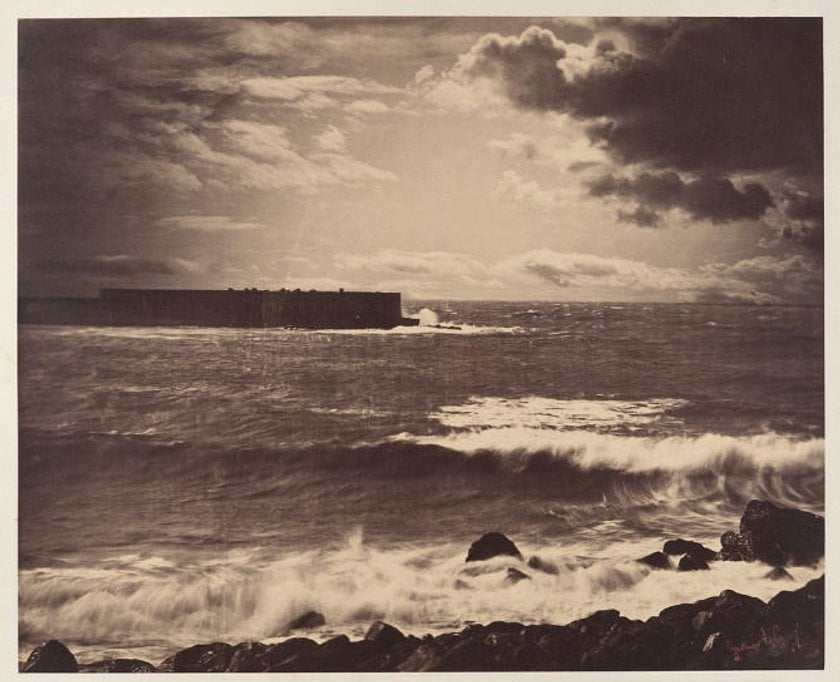 The Great Wave, Sète - Gustave Le Gray
The Great Wave, Sète - Gustave Le Gray
25. Wikipedia currently divides photography into 80 genres and 10 sub-genres.
26. If you’ve used Windows XP in your lifetime, you know the default wallpaper. It’s the world’s’ most viewed photo.
27. According to Guinness, the world’s longest photo negative is over 260 feet long!
28. Over 10 million photos have been edited in Aurora HDR and shared to social networks.
29. In 1858, French photographer and balloonist Gaspard-Félix Tournachon (better known as “Nadar”) took the world’s first aerial photograph. The photo was taken over the Bievre Valley in France. Unfortunately, that image no longer exists. The oldest aerial photograph that’s still around dates to 1860 and was taken by James Wallace Black, who used a tethered balloon to photograph the city of Boston.
 'Boston, as the Eagle and the Wild Goose See It' by James Wallace Black
'Boston, as the Eagle and the Wild Goose See It' by James Wallace Black
30. Photography Facts: Mac Fans Edition — Photoshop 1.0 was released in February 1990, exclusively for Macintosh computers.
31. Leonardo da Vinci accurately described the physics that make photography possible more than 300 years before the process was actually invented.
32. In 1935, Captain Albert Stevens took a photo from the Explorer II, a balloon that reached a record-setting altitude of 72,395 feet. It was the first photo to show the curvature of the Earth.
33. Leland Stanford (yes, that Stanford) hired photographer Eadweard Muybridge to settle a debate: Is there ever a point in a horse’s full gallop when all four hooves leave the ground? Muybridge used 12 cameras and a tripwire shutter rig to prove that all four hooves are indeed off the ground at the same time. (Some say that the debate, besides being a matter of scholarly interest, also involved a $25,000 bet.)
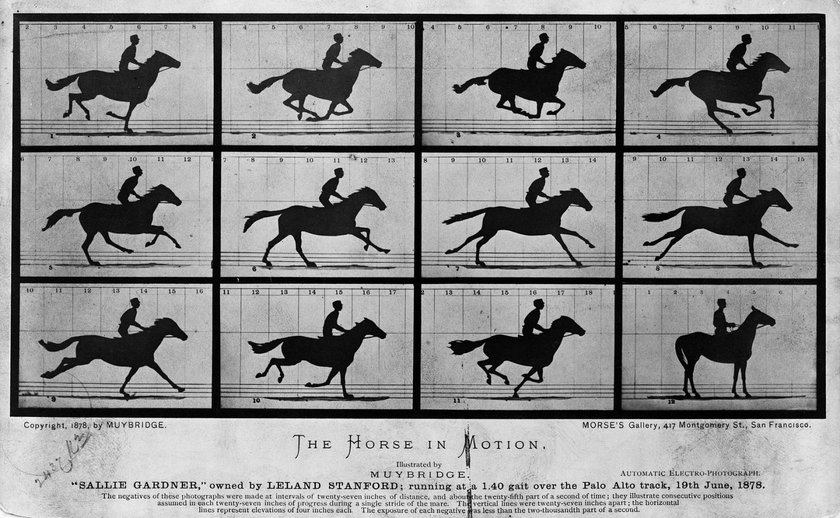 The Horse in Motion, by Eadweard Muybridge
The Horse in Motion, by Eadweard Muybridge
34. Here are some photography facts to get your feet wet: Louis Boutan, a French scientist, created the first dedicated underwater camera system in 1893. However, William Thompson had taken the first underwater photo almost 40 years before, in 1856.
35. In 1900, the Chicago & Alton Railway commissioned photographer George R. Lawrence to build what was, at the time, the world’s biggest camera to capture the entirety of the Alton Limited, “the handsomest train in the world.” The camera featured bespoke Carl Zeiss lenses, also the biggest of their kind.
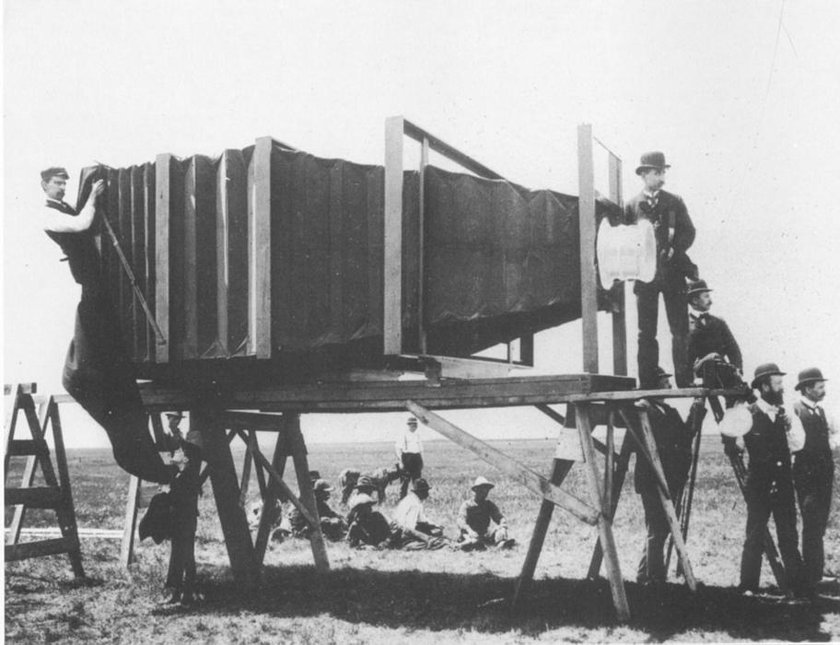 The giant camera. George Raymond Lawrence
The giant camera. George Raymond Lawrence
36. In the earliest days of photography, asphalt varnish was painted onto copper or glass plates to make the original “photographic paper.”
37. If you worry that film is on its last gasp, here are some heartening photography facts for you: Sales of black-and-white film have been increasing by about 5% annually for the past several years. Approximately 60% of those shooting on film say they started with that medium within the last five years.
38. Qatar’s Sheikh Saud bin Mohammed Al-Thani special ordered an APO-Telyt-R 1:5.6/1600mm lens from Leica. It cost $2,064,500, making it the world’s most expensive consumer camera lens to date.
39. The largest known SLR lens is the 5200mm f/14 Tele-Monster, made by Canon. It focuses on objects between 18 and 32 miles away.
40. The thread size of the tripod attachment on your camera is the same as the bolt on a typical lampshade. That means you can pull the shade off any old lamp and have your own jury-rigged tripod. (Who knew facts about photography could be so useful?)
41. Peter Lik holds the record for most expensive photograph ever sold. One of his pieces sold for a cool $6.5 million in 2014.
42. The most liked image on Instagram is a photo of an egg on a white background. The image, originally taken by Shutterstock contributor Serghei Platanov in 2015, was posted to Instagram by advertising specialist Chris Godfrey specifically to garner the highest number of likes on any Instagram post. At the time of writing, the egg has more than 53.2 million likes.
43. Cecil Beaton, one of the most famous photographers and costume designers of the 20th century, got his start designing book jackets and costumes for charity matinees. His first camera was a Kodak 3A, or the No. 3A Folding Pocket Kodak.
44. Aerial photography for military reconnaissance was first used extensively in World War I.
45. Helen Levitt, a founder of the street photography movement who’s been called “the most celebrated and least known photographer of her time,” spent 60 years taking candid photos on the streets of her native New York City.
46. On January 26, 1949, Edwin Hubble captured the first image through the Hale Telescope.
47. On April 10, 2019, the world got its first-ever glimpse of a black hole thanks to an algorithm created by MIT grad student Katie Bouman. Talk about far-out photography facts.
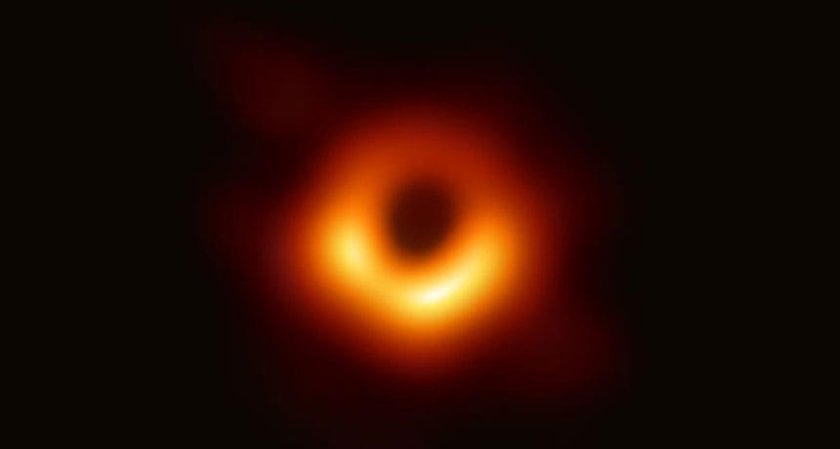 The first direct image of a black hole
The first direct image of a black hole
48. More fun facts about photography that are actually pretty sweet hacks: If you don’t want to shell out for an underwater camera rig, a small fish tank can work in a pinch. Set your camera in the fish tank, put the fish tank in the water, shoot through the wall of the tank, and voila — painless underwater or split-frame shots. Note: We really, seriously only recommend this in very shallow water so that you can set the fish tank on the bottom.
49. More than 40 billion (with a “b”) photos have been shared on Instagram.
50. All those photos rack up about 3.5 billion likes on Instagram each day. Okay, these stats aren’t strictly photography facts, since there are also videos and screenshots and cat memes being shared on Instagram. Still, if you’re a photographer who shares their art through this platform, it’s pretty interesting stuff.
51. Most historians consider 1914 to be the start of the abstract photography movement. The beginning of the movement is marked by Symmetrical Patterns from Natural Forms, a photo series by Erwin Quedenfeldt.
52. Photography had some big-league early supporters. Queen Victoria and Prince Albert were both significant patrons of photography. They even had a darkroom built in Windsor Castle.
53. In 1849, John Adams Whipple, a daguerreotypist, collaborated with astronomer George Phillips Bond to take what is widely recognized as the first high-quality photograph of the moon. That photograph is currently in the Met’s collection.
54. Although daguerreotypes and ambrotypes were both widely available by the time of the Civil War, iron tintypes were the most popular. They were durable enough to be easily mailed between soldiers and their families back home.
55. Early aerial photographers employed an impressive variety of methods to get the shot. Cameras were attached to kites, rockets, and pigeons.
56. Color photography first appeared on the cover of National Geographic in 1959. The photo was of an American flag.
 National Geographic Magazine cover, July 1959
National Geographic Magazine cover, July 1959
57. The first Impressionist exhibition was held in 1874, at 35 Boulevard des Capucines, Paris — formerly the studio of groundbreaking photographer Félix Nadar.
58. In the 1860s, William H. Mumler was a pioneer of spirit photography, or the use of photography to capture paranormal phenomena. He was outed for fraud after living Boston residents appeared in his photographs as “ghosts.”
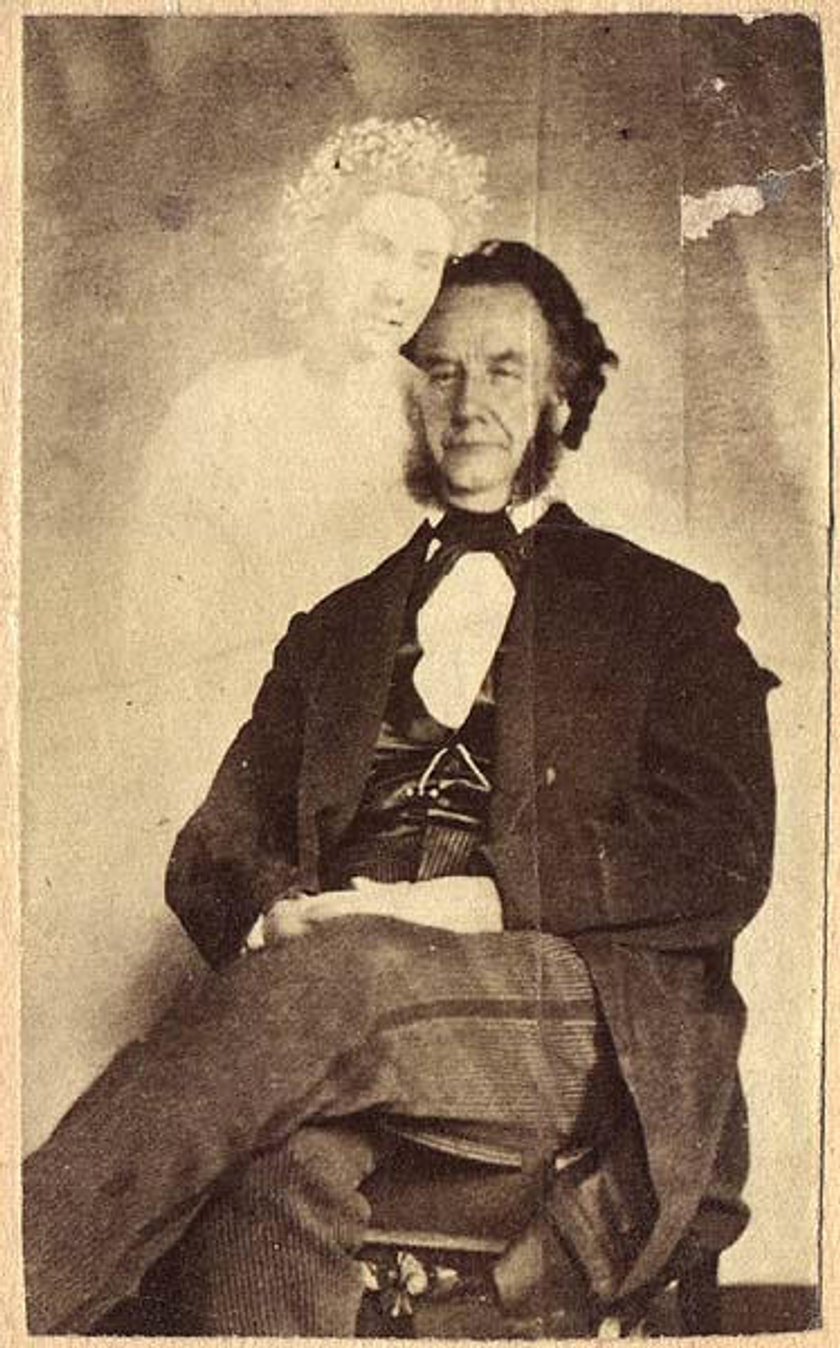 William H. Mumler's spirit photography
William H. Mumler's spirit photography
59. Arthur Conan Doyle, author of the Sherlock Holmes series, was a dedicated believer in spirit photography despite clear evidence of image manipulation. In 1922, he even published a book called The Case for Spirit Photography.
60. Speaking of photographic manipulation: The most popular Instagram filter (after Normal) is Clarendon, followed by Juno and Ludwig.
61. Senior portraits (of high school seniors) are a longstanding tradition in America, originating in the 1880s or even earlier.
62. Fun facts about photography for the practical-minded: A white balloon will work in place of a softbox light.
63. A total of six different dogs have graced the cover of National Geographic. Of these, the best-selling issue belonged to Betsy the border collie (“Animal Minds,” published in March 2008).
64. The first-ever selfie was taken by Robert Cornelius in 1839.
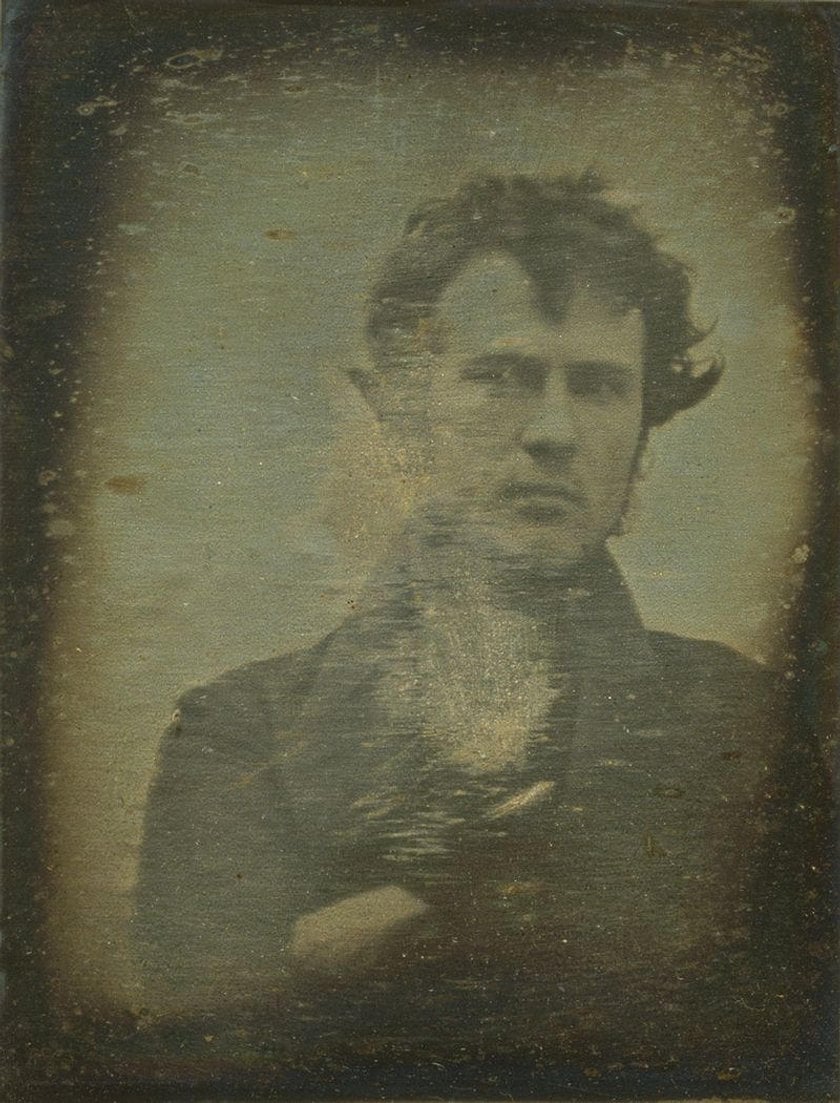 Robert Cornelius
Robert Cornelius
65. Funny cat photos are a similarly storied tradition. Some of the first, taken by Harry Pointer, date back to the 1870s and feature Pointer’s cats riding tricycles and rollerskating. (These are photography facts to make us all proud.)
66. Film can be developed using coffee (or tea). The process is called Caffenol.
67. At 564 pounds, the Carl Zeiss Apo Sonnar T* 1700 mm f/4 lens takes the title for the world’s heaviest lens for civilian use. It’s made by special order only.
68. No one knows exactly where the term “gobo” (meaning a stencil used to produce a pattern of light and shadow for a stage production or photograph) came from. When the word was first used back in the 1930s, it referred to sound-absorbent material placed on the side of a microphone to block sound — it had nothing to do with light at all.
69. Early photography was full of unique development processes that have been largely forgotten over time. One of these, called chrysotype, used colloidal gold to record images.
70. According to a study from Wake Forest University led by Kelsey Blackburn and James Schrillo, the left side of our faces appears better in pictures and is perceived as more attractive than the right side. Take note, portrait photographers.
71. Facts about photography aren’t just little nuggets of information for trivia night — they can also be really useful for building your photography business. For example, Instagram isn’t the only important social media network for photographers. Did you know that Reddit, as the third most visited site in the US, is one of the best platforms for photographers to reach an audience?
72. Tintype, one of the most popular early photographic processes, was also known as melainotype or ferrotype.
73. Founded in 1853, London’s Royal Photographic Society is the world’s oldest photographic society in continuous existence.
74. Now for photography facts not for those with acrophobia: The iconic image of the Grand Prismatic Spring at Yellowstone National Park, used on the August 2009 cover of National Geographic, was taken by George Steinmetz while he stood on the skids of a helicopter.
 National Geographic, August 2009. Cover photo by George Steinmetz
National Geographic, August 2009. Cover photo by George Steinmetz
75. As of this writing, there are 53,122,569 images and other media files available on Wikimedia Commons.
76. Europe’s first museum of photography was the Musée de l'Élysée in Lausanne, Switzerland. It was founded in 1985, and it’s still around today. (Photography facts can also be great travel inspiration!)
77. Most photography captures the same spectrum of light that’s visible to the human eye, but some photography captures light outside that range. The official term for this is multispectral imaging, and it includes infrared, ultraviolet, and full-spectrum photography.
78. If you’re the type of person who enjoys looking through the arrest reports on Monday mornings, we’ve got some fun photography facts for you: Back in the day, police stations kept large collections of mugshots of wanted criminals. They were called the rogues’ gallery.
79. Kirlian photography is a unique form of photography that involves capturing electrical coronal discharges. It’s been used in everything from traditional scientific research to paranormal investigation and abstract art.
 Kirlian photo of a Coleus Leaf. Photography by Wikipedia User:MrX [CC BY-SA 3.0 (https://creativecommons.org/licenses/by-sa/3.0)]
Kirlian photo of a Coleus Leaf. Photography by Wikipedia User:MrX [CC BY-SA 3.0 (https://creativecommons.org/licenses/by-sa/3.0)]
80. In the early days of photography, pioneers like William J. Newton, Robert Demachy, and Alfred Stieglitz embraced a movement called Pictorialism, in which photographers used soft focus to imitate the dreamy, romantic look of paintings.
81. As a contrast to the Pictorialism movement, photographers like Ansel Adams and Willard Van Dyke promoted the idea that photography should embrace principles of “clearness and definition,” avoiding the pre-photography ideals of fine art. The group of photographers espousing this philosophy was known as Group f/64.
82. The name “Group f/64” is a reference to a small aperture setting used on a large format camera, which will produce an image that is in sharp focus from foreground to background.
83. The famous advertising slogan “You Press the Button, We Do the Rest” was coined by Kodak founder George Eastman in 1888. His idea to make the previously complicated process of photography simple and accessible for amateurs and hobbyists helped propel photography to global popularity.
84. One of the most famous photography exhibits was called The Family of Man. It debuted in 1955 at New York’s Museum of Modern Art and then toured internationally for the next eight years, drawing 9 million visitors in total. It still holds the title for the most-viewed photography exhibit of all time.
85. Some of the highest-quality early photographs were produced using Woodburytype, a printing process that creates a molded copy of an original photographic carbon print.
86. According to some sources, the first woman to ever take a photograph was Anna Atkins.
Others say that it was Constance Fox Talbot (wife of famed photography pioneer William Henry Fox Talbot).
87. No matter which woman took the first photo, there’s less doubt that Atkins was the first person to ever publish a book illustrated with photographs. It was called Photographs of British Algae: Cyanotype Impressions, published in October of 1843. The book was privately published and featured handwritten text.
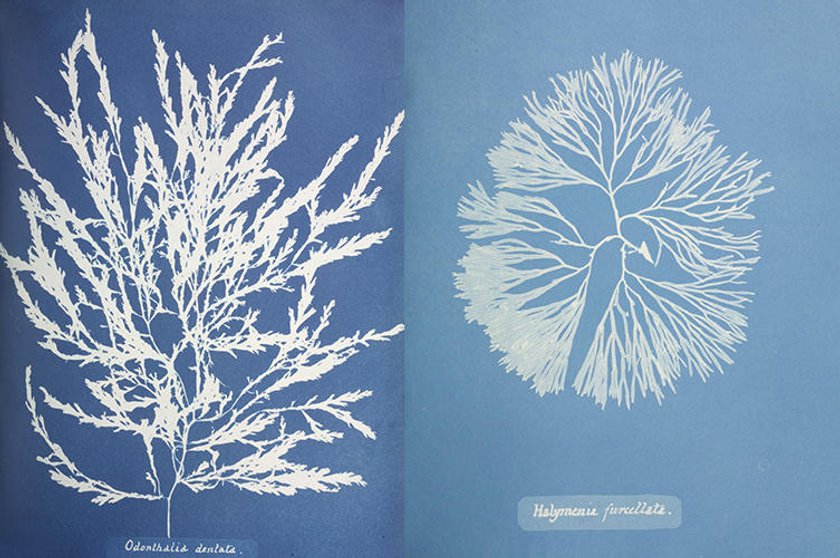 Anna Atkins. Photographs of British Algae: Cyanotype Impressions
Anna Atkins. Photographs of British Algae: Cyanotype Impressions
88. The West wasn’t the only place where the new art of photography began to flourish in the 19th century. In 1889, Ogawa Kazumasa and Kajima Seibei, among others, founded the Nihon Shashin-kai, or Japan Photographic Society.
89. The October 1978 issue of National Geographic features a mirror selfie taken by Koko the gorilla, who had a repertoire of almost 1,000 words in American Sign Language. At the end of Koko’s photography session, she signed “love camera.” (We personally believe this is one of the cutest photography facts out there.)
90. Arthur C. Pillsbury was one of the pioneers of time-lapse photography. Beginning in 1911, he took time-lapse photos of 500 of Yosemite’s 1,500 varieties of wildflowers.
91. Facts about photography, especially wildlife and nature photography, are often facts about conservation too. For example, those time-lapse photos that Pillsbury took? They convinced the United States Cavalry to stop mowing the meadows of Yosemite and to begin preservation work instead.
92. Most of us know the “Gaussian blur” effect in Photoshop. It’s named after Carl Friedrich Gauss, a German mathematician and physicist who proved that an imaging system can be characterized by three pairs of points: the focal points, the principal points, and the nodal points.
93. Of course, photography is an art, but we’ve got some photography facts for the technical types too: JPEG, the most common compression format for digital images, stands for Joint Photographic Experts Group.
94. En Foco is one of the leading photography nonprofits in the US. Founded in 1974, the organization’s mission is to nurture and celebrate cultural diversity in photography by supporting photographers of color and of diverse cultural backgrounds.
95. For some facts about photography that go way, way back, we look to Ancient Greece. Mathematicians Euclid and Aristotle both independently described the mechanics of a pinhole camera. That was in the 4th and 5th centuries.
96. Film comes in numerous sizes below 35mm, including 9.5mm, 16mm, 17mm, and 17.5mm. Photography using these film types is officially known as subminiature photography.
97. Subminiature photography shouldn’t be confused with photomicrography, which is the process of capturing images of very small objects through a microscope or similar magnifying device.
98. The Société française de photographie was founded in 1854, and it’s solely dedicated to the history of photography.
99. The Aperture Foundation, a nonprofit institution founded by Ansel Adams, Barbara Morgan, Dorothea Lange, Nancy Newhall, and other prominent 20th-century photographers, publishes books of photography. It currently has over 600 titles in print, some of which have been in print for over 40 years.
100. Some of the earliest color photographs, dating back to the 1840s, would have required hours- or even days-long exposures for a single frame.
101. And now, to close our list, we’ve got some facts about photography and its future. According to predictions from the Cooperative of Photography, here’s what’s next for this art form: cameras with hundreds of megapixels of resolution, completely flat cameras with no moving parts, and “smart” cameras that can be controlled with eye movements — or even brain waves.
Bottom Line
If you weren’t aware of these photography facts, you’re sure to have found some interesting things about the art form in this article. And if you’re new to photography, then hopefully these facts have made you more passionate in your work.
So go out, take some photos, and share them with the world! But just keep in mind that a little help never hurts, which is why you should take a close look at Skylum’s excellent photo editor that you can try for free! It will not only make photography easier but will also teach you a lot about post-processing, something that’s crucial if you’re going to make a name for yourself in the world of digital photography.



